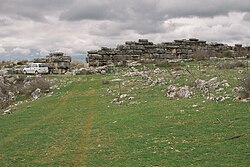- The 1,250 t heavy Thunder Stone in Saint Petersburg, Russia. On top is an equestrian statue of Peter the Great
- The 53.3 t heavy capital block (the rectangular platform fitted with a railing) of Trajan's Column in Rome, Italy, was lifted by Roman cranes to a record height of about 34 m
- The Western Stone of the Western Wall in Jerusalem weighs 517 t.
- Neolithic Carnac Stones, France
- Brownshill Dolmen, Ireland (4th millennium BC). The great capstone weighs about 100 tons.

This is a list of monoliths organized according to the size of the largest block of stone on the site. A monolith is a large stone which has been used to build a structure or monument, either alone or together with other stones. In this list at least one colossal stone over ten tons has been moved to create the structure or monument.
Contents
- In situ monoliths
- Moved monoliths
- Lifted monoliths
- Erected in upright position
- Lifted clear off the ground
- List of efforts to move and install stones
- Calculating the weight of monoliths
- Volume
- Density
- See also
- References
- Sources
In most cases ancient civilizations had little, if any, advanced technology that would help them move these monoliths.[ citation needed ] The most notable exception is that of the Ancient Egyptians, Ancient Greeks and Romans, who had cranes and treadwheels to help lift colossal stones (see list of ancient Greek and Roman monoliths).
This article also includes a list of modern experimental archaeology efforts to move colossal stones using technologies available to the respective ancient civilizations.
Most of these weights are based on estimates by published scholars; however, there have been numerous false estimates of many of these stones presented as fact. To help recognize exaggerations, an introductory description shows how to calculate the weight of colossal stones from first principles.








